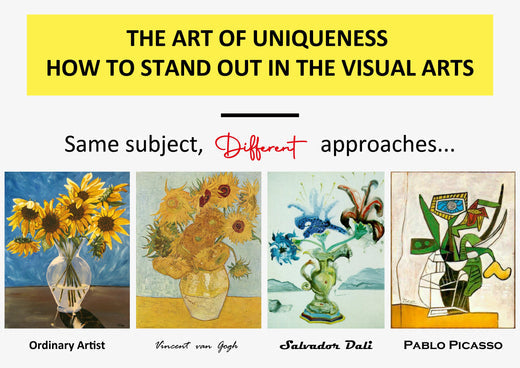The Art of Uniqueness: How to Stand Out in the Visual Arts
by Joni Margjeka

The world of visual arts has always been a rich tapestry of styles, techniques, and perspectives. The image above perfectly encapsulates how artists can interpret a seemingly simple subject, such as a vase of flowers, in profoundly different ways. From the literal representation by an ordinary artist to the expressive brushstrokes of Vincent van Gogh, the dreamlike surrealism of Salvador Dalí, and the abstract cubism of Pablo Picasso, each artist demonstrates a unique voice that sets them apart.
Standing out in the visual arts is essential because art is not merely a mirror of nature but an expression of individual perspective, emotion, and interpretation. While nature provides endless inspiration, replicating it exactly diminishes the opportunity for creativity and innovation. By representing the world through a unique optic, artists contribute to the diversity of human experience and provoke thought, dialogue, and emotional engagement in ways that pure imitation cannot.
Art gains its power when it communicates the artist's inner vision, transforming the familiar into something new and evocative. It allows viewers to see the world through different lenses, uncovering hidden layers of meaning or beauty. Unique representation also helps an artist to establish a distinct voice in the crowded art world, leaving a lasting impression and forging deeper connections with the audience. In essence, by moving beyond imitation, artists honor both their individuality and the transformative potential of art itself.
In this article, we’ll explore the concept of uniqueness in visual arts and offer tips on how you can cultivate authenticity and individuality in your artistic practice.
Why Uniqueness Matters
Uniqueness is what transforms art from a mere craft into a powerful form of self-expression. It is the artist’s fingerprint, their way of interpreting and responding to the world. Without uniqueness, art risks becoming generic and loses its emotional resonance with the audience. When artists dare to be different, they inspire thought, provoke emotions, and often redefine entire movements.
Lessons from the Masters
The image above highlights the transformative power of personal style:
- The Ordinary Artist: While technically proficient, this approach lacks the emotional depth or distinctiveness that elevates art. It serves as a reminder that replication without interpretation rarely captivates.
- Vincent van Gogh: Van Gogh’s sunflowers are bursting with life and emotion. His bold use of color, texture, and impassioned brushstrokes make his work instantly recognizable. He teaches us to channel emotion into our art.
- Salvador Dalí: Dalí takes the ordinary and makes it extraordinary, transforming a simple vase of flowers into a surreal dreamscape. He challenges us to see the world through a different lens and embrace imagination.
- Pablo Picasso: Picasso’s cubist take on the subject demonstrates his willingness to deconstruct reality and rebuild it in a way that is uniquely his. His work encourages us to break free from conventions.
How to Cultivate Authenticity as an Artist
If you’re striving to develop a unique voice in the visual arts, here are some actionable tips:
1. Find Inspiration, Not Imitation
Study the works of great artists, but don’t replicate them. Instead, ask yourself what resonates with you and why. Use these insights to inform your own creative choices.
2. Experiment with Techniques
Try different mediums, styles, and approaches. Step out of your comfort zone and explore new ways of creating. The process of experimentation often leads to breakthroughs in artistic identity.
3. Embrace Your Perspective
Your experiences, culture, and emotions are unique to you. Infuse your art with your personal story and worldview. Authenticity stems from being true to yourself.
4. Focus on Process, Not Perfection
Don’t strive for flawlessness. Some of the most compelling art comes from imperfection and spontaneity. Allow yourself the freedom to make mistakes and learn from them.
5. Challenge Conventions
Break the rules and question norms. As seen in Picasso’s work, challenging traditional perspectives can result in groundbreaking art.
6. Reflect and Refine
Regularly reflect on your work and ask yourself: Does this feel like me? Is this the story I want to tell? Use these reflections to refine your style over time.
The Courage to Be Different
Being unique in the visual arts requires courage. It means embracing vulnerability, standing out, and sometimes going against the grain. But it is this courage that makes art memorable and impactful.
Like Van Gogh, Dalí, Picasso, and many other notable artists, you have the power to leave an indelible mark on the art world. By staying true to your vision and continuously evolving, you can create work that is authentically yours and resonates deeply with others.
In the end, art is not about replication but transformation. It’s about how we, as creators, interpret the world and channel it into something deeply personal yet universally resonant. “My art does not aim to faithfully imitate nature but to be inspired by it in a way that creates imperceptible realities”. New worlds where imagination and reality converge, inviting others to see through a lens uniquely my own. Through this approach, I hope to honor the beauty of nature while giving life to something distinctly original.
So, pick up your brush, pencil, tools, or camera, and dare to be different. The world doesn’t need another ordinary artist, it needs your unique voice.

